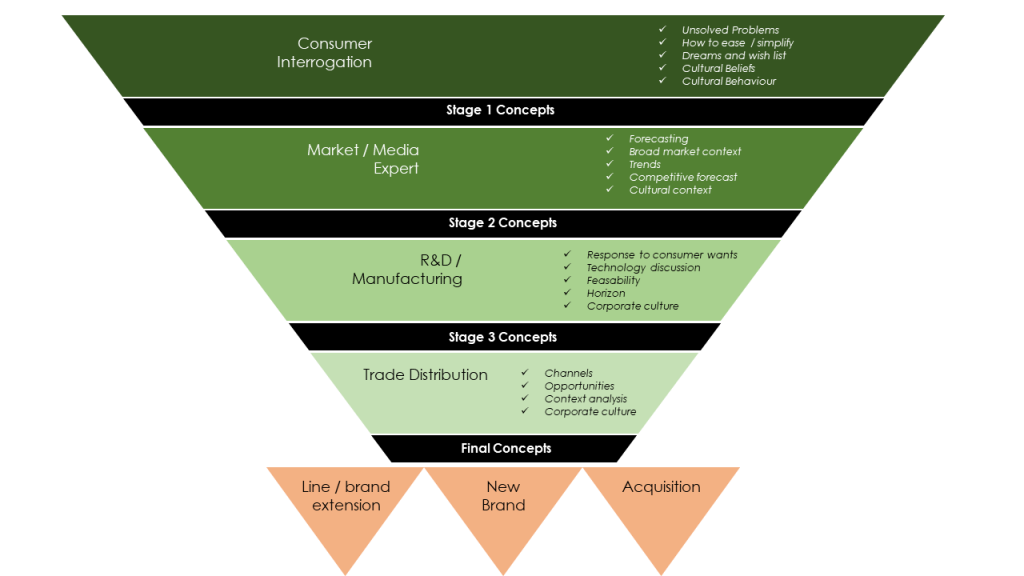
We create innovation strategies. Just as we help brands define a brand strategy, we help innovators define an innovation strategy – to drill where there is a good chance of striking oil.
Innovation has become, for most companies, a pivotal way to grow their business, and a condition to maintain it. Yet it is commonly a source of disappointment, to say the least. The rate of failure is high. Mark Payne suggests, in “How to kill a Unicorn”, that it is around 90%. His observation that many innovation teams focus on the “wow”, rather than on the “how” pin points the problem. Most innovation processes are designed to favour the search for “new and different” as the primary goal; the “wow” factor is paramount. Naturally a lot of research is done, both in terms of consumer acceptance and in terms of feasibility and implementation. But the premise is to come up with a “new and different” idea, then try to make it work, rather than explore and understand the consumer, manufacturing, distribution or communication opportunities first, and then create a new product or service. A further dimension of the “how”, crucial, but less often explored, is how to execute an innovative idea in a given culture; and here by culture, we mean both social and popular culture, as well as corporate culture.
Solving an unsolved problem
Rather than simply concentrating on the new and different, most very successful innovations are born of solving an unsolved problem. Airbnb was born not of trying to find a platform for booking rooms, but of finding accommodation in cities with few hotels but plenty of vacant flats. Smart phones made it possible to take computing and research tasks outside of homes and offices, without the need for a computer. Hybrid cars made it possible to drive an electric vehicle without having to worry about range. On line shopping made it possible to shop without having to move and travel. Solving a yet unsolved problem is what W. Chan Kim and Renée Mauborgne call a “Blue Ocean strategy”: according to them, Uber and Lyft succeeded primarily because they addressed problems people experienced with transport that other services (taxis) were not tackling. The first question an innovation project should ask is: what is the unsolved problem we could solve?
Adding, or removing?
Most major innovations are about removing, rather than adding. Great innovations are ones that remove a chore, hence facilitate people’s lives. Home appliances were developed to remove household tasks. Tap and go cards removed pins and signatures. Nespresso capsules removed the need to fiddle, dose the coffee and boil the water. In home delivery removes the trip to and from the store. Face recognition removes pins and passwords. Phone pay removes the need for a wallet. Removal is also about the bits and bobs that can be removed to facilitate and simplify: Dyson removed bags, then wire, from vacuum cleaners. Chromebooks remove laptop components and apps that are useless for the cloud data generation, making PCs faster and cheaper. Hence, the second and third questions an innovation project should ask are: what chore can we remove? How can we simplify the category, to make people’s experience easier, simpler, smoother?
Moving up the brand’s value
Many innovation projects aim to move up the brand’s value. To offer a more valuable experience to “premiumize” the brand experience. Is premiumization any different, does it follow different innovation rules? Is the “wow” for premium more important than for “basic” and “mainstream” products and services? In fact, perhaps surprisingly, it is not the case. Premium today is still about the hassles being removed, and problems being solved. Wanting to feel fresh after a flight? Take a shower in the air. Premium headphones? You won’t find the wires. The most sophisticated food? It’s purely natural, no additives.
Cultural relevance
To be successful, an innovation must also be relevant in the culture. Obviously, the success of digitally based innovations is accelerated by a general cultural context that values the benefits of technology. For example, there is no doubt that Uber would not have gained such a cultural and social saliency if the brand hadn’t been a showcase of the way digital apps can revolutionize people’s daily life. Innovations must meet, ad minima, social acceptance, and ideally, social meaningfulness. The contemporary interest for better nutrition is another example of a cultural movement that can give momentum to innovations. Conceptions and definitions of health impact on how health innovations are received in a particular geography: in America, where “body is a machine”, health is about improving the input. In other geographies with a more organicist concept of the body, in continental Europe for example, health is about reinforcing vitality. As cultural experts, it is an area of particular focus for us: how will the innovative concept be received in this particular culture? How will it resonate, will it? Or will there be cultural huddles that need to be overcome?
Corporate culture
Corporate culture is also of pivotal importance, and a key dimension of the “how”: is the innovative concept consistent with the company’s business models and behaviour? Does it build on the company’s strengths, or does it require a stretch? Does the company have the cultural expertise and appetite to venture in this new area? Is it equipped to respond to an unfamiliar environment?
Drilling to strike oil
Emotional design and emotional spaces. Future trends. Futuristic and breakthrough aims. All these themes are very important. Innovations need to look and feel contemporary, and forward looking. But this is no substitute for a rock solid foundation: what problem is this solving? What is it simplifying? What chore is it removing? How relevant is the innovative idea in the broad culture? In the company culture? Before we engage in the creative process, we need to get the base right. That’s what we do – we are the foundation builders. Our work is to inform the creative process so the creatives will drill in the right spot to strike oil.
So, How we do it?
By asking these questions, the fundamental questions, of the people who are instrumental to the” how”: consumers, market experts, media, R&D and manufacturing experts, distribution and sales experts.
To consumers we drill down to reveal the problems experienced with this category. What are the chores? What task or step would you like removed? What problem would you like solved? What is it in the product experience that you really want, and what is it that you don’t want? How can we make it simpler? How can we make it easier? With consumers, we also work on projections, dreams and wishes. The ideal product; what does the future look like; what’s their wish list?
And of course we go beyond – we explore the culture that surrounds the category and the brand. What are the cultural patterns? What are the cultural rituals and beliefs that determine people’s perceptions and behaviour in this category? It’s well and good to remove a task, but what if this task has cultural significance? On the other hand, how can the cultural context create momentum in favour of our project?
With market and media experts, our conversation is focused on forecasting, engaging them to project into the future, evolutions that will happen, problems that will be solved, technologies that are expected to come, social and societal changes that will have an influence, future dynamics, future competitive landscape, future challenges and risks. Market and media experts are also extremely important to understand the cultural context that surrounds the project, and how it can help, or be a challenge.
With R&D and manufacturing experts, our goal is to understand the grit of the “how”: what is feasible, what is out of reach. Working from the list of consumer challenges, unsolved problems, desires and wants, as well as from the experts’ forecast lists, we review what technology and manufacturing can deliver, and what is the horizon. With these experts, we also review both limitations and potentialities that are inherent to the company’s modus operandi: is the company nimble, can it adapt to the environment the project suggests to play in, will it be a stretch, how can the company adapt, etc…
Lastly, with distribution and sales, we conduct a similarly crucial discussion, in a world where both trade and distribution are changing at a rapid pace, making innovative approaches more actionable than they were before, and experiments easier to undertake. And as with R&D and manufacturing experts, we explore companies’ corporate culture, what retail environment they are more comfortable with, what distribution strategies they master and what channels they dominate: no matter how brilliant an innovation is, it will fail if it can’t make it to the shelf.
How intense is the change
The final big part of the how is to choose the right approach to bring an innovation to life. Innovation can mean various intensities of change: it can be an evolution, it can be a step change, or it can be a total revolution, stepping into unchartered territory. Depending on the magnitude of the change, a crucial part of the “how” is to decide whether to launch at the core of the business (and brands), or at the periphery, for example as a separate brand or business. And in some cases, if the cultural and organisational changes needed to succeed are particularly large, the best innovation strategy could be for the innovation team to recommend acquisition.
Too intense a change can lead an innovation to failure. This happens more often than the opposite. It is yet another reason why the “how” is so important, and why a blind focus on the “wow” leads to failure. An effective innovation strategy should also be examining whether a change is possible and actionable. A small successful innovation beats a big failed one.
Innovation funnel
Our innovation funnel is our roadmap; it makes sure that at every step, we’ll check the “how”, so that we can put the finger on innovation that really solves unsolved consumer problems, making their lives easier and more enjoyable, with a deep resonance in the broader culture, innovation that media will be happy to talk about; innovation that the company can develop, produce, distribute and sell with efficiency and enthusiasm.

A&P.
